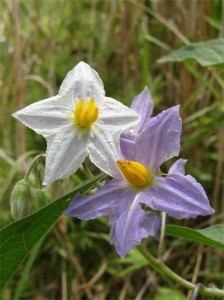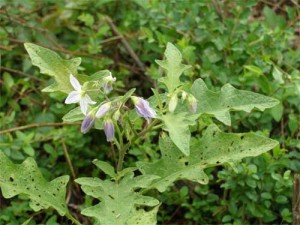Beautiful, spiny horse nettle

Quarter size flowers of weedy horse-nettle are as beautiful as any ‘garden’ flower. Photo by Ken Moore.
By Ken Moore
“I’m always nervous about reading in Flora that I have yanked out another one of those wild weeds for which you have such high regard.â€
That was the response from gardening friend Diana following my expressed enthusiasm in spying a horse nettle in her curbside garden along Mason Farm Road. She timidly admitted that it was one that had escaped her weeding earlier in the day.
Diana’s curbside, and the rest of her yard, is one of my favorite gardens because it is carefully managed so that it appears not to be managed.
Knowing that her garden is frequently being discovered and enjoyed by young children, I offered an understanding nod, because the very poisonous berries of horse nettle mimic the appearance of those tasty yellow-gold cherry tomatoes. Diana is wise to keep those low-to-the-ground tomato-looking fruit away from the natural curiosity of children, who likely have learned that anything looking like a cherry tomato must be a cherry tomato.
Where young ones are not likely to get their hands on the poisonous fruit, however, I encourage you to allow horse nettle, Solanum carolinense, a bit of freedom in your garden. Each time I see it in flower, I stoop down to admire those white and purplish-blue flowers, looking so much like tomato flowers on steroids.
Occasionally, you will stumble upon one that looks like a garden plant. That happened last week while I was walking along the fields of the Botanical Garden’s Mason Farm Biological Reserve. One such garden-plant specimen visually jumped out from the field edge. The oversized flowers were a real visual treat.
Some of you may remember an experience similar to that described by Paul Green (Paul Green’s Plant Book): “This pest used to play havoc with our bare feet as children, especially if the dead dried plants chopped up by the hoe were stepped on. The thorns were sharp as little needles.â€
If you take a closer look you will easily see the spines along the stems, as well as on both sides of the leaves. You definitely tread softly when moving barefoot among horse nettles.
It is commonly found in sunny disturbed areas, which is why this native is sometimes considered a pest in cultivated areas. But in the natural succession of plant growth, horse nettles give way to larger perennials and eventually to competition of shrubs and trees. In the meantime, this drought-tolerant perennial provides a service with its vigorous tap root breaking up barren, sterile soil, gradually improving it for other vegetation following in its path.
Horse nettles are having a late-summer re-blooming fling just now, and though the little tomato-like fruit of the early-season’s flowers are already dispersed, you’ll likely be seeing fruit again later in the fall.
There are many descriptions of medicinal uses of horse nettles. The Cherokees, in particular, have an interesting heritage. Described remedies include stringing the roots around a baby’s neck for teething, making a grease of fried berries to treat mange on dogs and crushing leaves in milk to kill flies. One of the most intriguing to me is the application of wilted leaves to relieve irritation from poison ivy. I haven’t tried this yet, but certainly plan to do so.
So, take a closer look at those flowers and watch out for those spines!

Comments are closed.